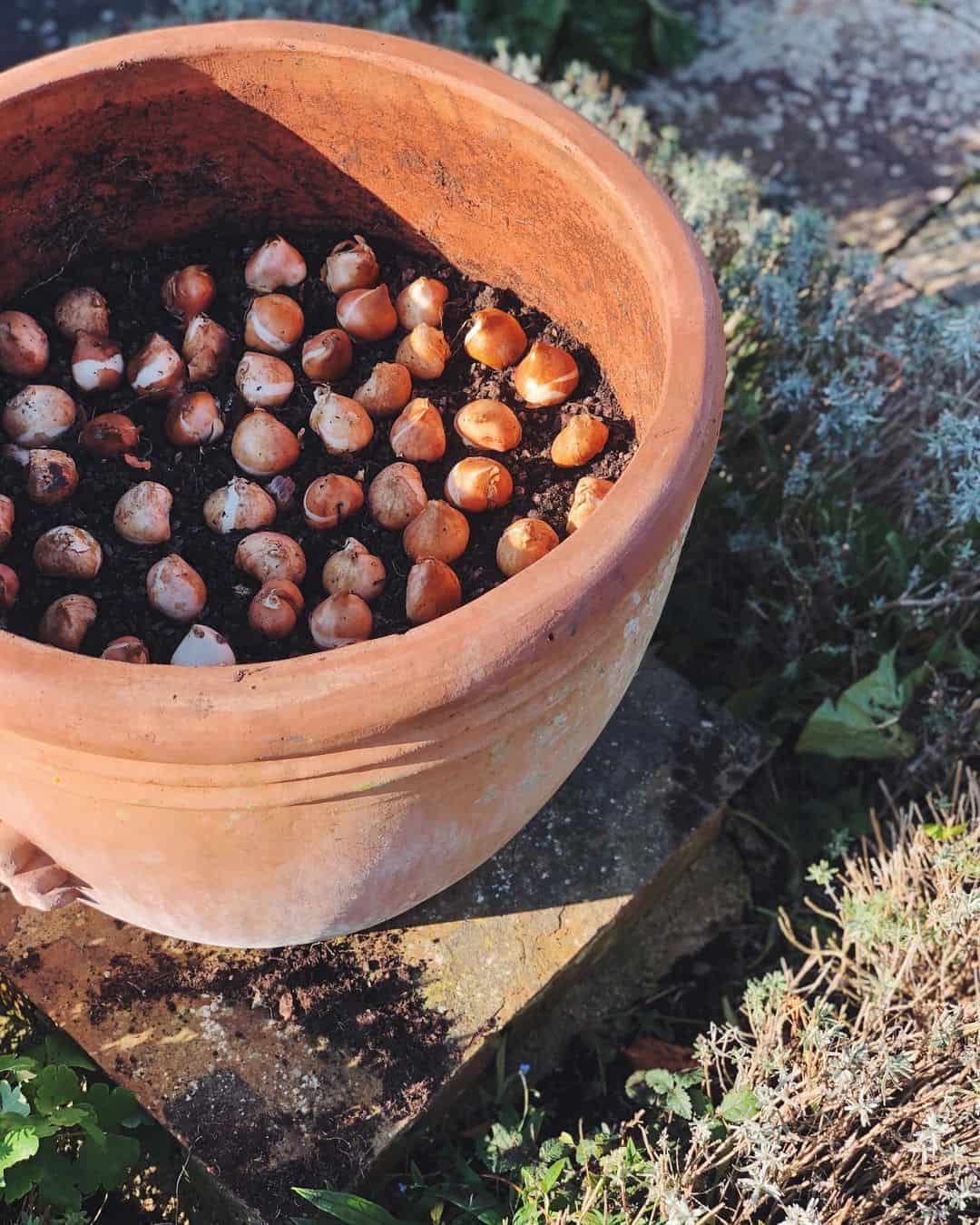The soil is warming up, the days are getting longer, and your garden is slowly waking. Now’s the time to help it spring back to life.
Preparing your garden for spring in late winter can help you take better advantage of the growing season by starting seeds indoors and getting the garden beds ready faster.
Read on to discover our top gardening tips for spring:
1. Tidy up your flower beds and compost organic matter

Credit: Shutterstock
Getting the flower beds ready for spring should be top of your list of priorities. Remove any leftover leaves, weeds and debris so that you can see the bare soil. Compost the leaves and debris but not the weeds, as they may return to haunt your garden.
Whether you also cut back old, dead growth is up to you. It can save you time in spring but old growth can provide shelter for small animals during the remaining period of cold weather.
2. Loosen up the soil in your vegetable garden

Image credit: @flowerstreetaz
During colder temperatures, the soil becomes compact. Before you begin planting in it, it’s a good idea to loosen it up. You can use a spade or a tiller for the task, depending on how much ground you have to cover.
Tip: Work the soil to a depth of at least 10 inches to make it easier for the roots of plants to become established.
3. Work organic matter into the soil

Feed your soil with nutrient-rich compost. Image credit: @gillianliveslightly
Once your garden soil is no longer frozen, you can start preparing it for plant life. Flower beds, borders, and vegetable patches can all benefit from organic matter. It will help your flowers and vegetables thrive once spring settles in your garden.
Work compost into the soil. If you don’t have compost, or if your compost is not yet ready, add a soil improver or well-rotted manure. You can buy soil improver in bales, sacks, or bags. Got a large garden? Buying organic matter in bulk will likely be more cost-effective.
But just how much organic matter should you add? The Royal Horticultural Society recommends adding 5 to 10 kg of organic matter per square metre for soil improvement. For no-dig gardening, add a thicker layer.
Tip: For best results, use well-rotted organic matter, which is dark and uniform in colour.
4. Rake the grass

Credit: Pixabay
Don’t forget about the grass. Before spring appears, you can rake the grass and scarify it to remove any harmful undergrowth like moss or weeds. It will help it to breathe better and absorb water and fertiliser more easily.
More on this: What to Do After Scarifying a Lawn: 9 Steps to Revive Grass
Tip: You may be tempted to apply fertiliser to and sow new grass seeds now but it’s best to wait until spring.
5. Prune roses and other plants and shrubs that need it

Image credit: @ardens_illustrated
Late winter is a good time to prune most roses. More than neatening them up, late winter pruning will help them bloom more beautifully.
Here are a few essential tips for pruning roses before spring:
- Cut away any dead or diseased stems.
- For large stems use a pruning saw or loppers.
- To encourage better growth, cut away old wood and stubs that performed poorly last flowering season.
- Make the cuts ¼ inches above buds.
- Use cuts to improve the airflow between stems and give them enough space to develop.
Bear in mind that some rose varieties have specific pruning requirements so always look them up before you begin.
6. Prune woody shrubs

Image credit: @petranyipince
The shrubs deserve a bit of styling too, right? Look for dead and diseased growth and do away with it. More than making your garden look good, pruning will encourage healthy growth in spring.
Don’t cut spring-flowering woody shrubs after growth begins or you’ll be nipping the buds. To be safe, stop pruning shrubs after late winter.
7. Start seeds indoors

Credit: Shutterstock
Whether you want to add more flowers or vegetables to your garden, it’s too cold to plant outside in January, so get the seeds ready for early spring planting.
Fill your seed trays or pots with pre-moistened seed starting mix and sow the seeds. Cover the larger seeds with ½ inch of seed starting mix. Place them in the kitchen or another warm room.
Note: Depending on the seeds you use, you’ll have to keep them in the dark or give them some light to germinate. Until they do, use a spray bottle to keep them moist but not wet.
Once the seeds germinate, move them to a south-facing window or another sunny spot. Before you transplant them to your garden, wait for them to develop a set of true leaves. These leaves are higher up the stem and can perform photosynthesis.
You can also harden them first to make it easier for them to become established. Keep them outside for a few hours and then move them back in for the night every day for a week. The following week, leave them outside at night too.
Tip: Don’t forget to label the seeds, especially if you plan on growing several different plants. After all, you don’t want to mix up onions with nasturtiums, do you?
8. Plant spring bulbs

Image credit: @dancoopergarden
If you didn’t plant tulips, daffodils, crocuses, or hyacinths in the autumn, you can put pre-grown spring bulbs in the earth now to enjoy beautiful flowers in spring.
The best part about these spring bulbs is that they will come back to your garden for years to come.
Tip: Plant bulbs with the roots down and the pointy side up. Read our full guide on how to plant bulbs for more tips.
9. Divide crowded perennials

Image credit: @eclecticforest
If you’ve got crowded perennials like hostas or shasta daisies in your garden, it’s a good idea to divide them to improve their appearance and give them more space to develop before they put on their spring growth.
To divide perennials without damaging them, dig around the clump and then under the root balls to lift the plants from the ground. Untangle the roots with your hands. Use a knife to cut clumps apart if needed. Replant the divided plants right away over a larger area, leaving enough space between them.
Tip: For large clumps, use a shovel or fork to divide them while they’re in the ground.
10. Provide birds with seeds

If birds love to visit your garden, why not make their life easier? Add one or more bird feeders to your garden and fill it with seeds. As well as helping the birds find food, you’ll also protect your fruit trees from their inquisitive pecking.
You Might Also Like: What To Feed Garden Birds In Spring (And When To Stop)
11. Build or repair raised garden beds

Image credit: @gillsgreenfarm
Raised garden beds are a clever way to grow flowers and vegetables if you have less than ideal soil in your garden. You can fill them with just the right soil for your plants to thrive in.
If you’ve always wanted one or two raised garden beds but never got round to building them, now’s a good time to do it. You can build simple raised garden beds from cedar or breeze blocks or railway sleepers. Or you can get a raised garden bed kit.
Already have a raised garden bed or two in your garden? Inspect them for any damage, add braces to warped corners if needed and seal them with linseed oil, beeswax, or another non-toxic sealant. Now’s also a good time to replenish the soil in them and add organic matter.
12. Clean and repair your greenhouse and other garden structures

Image credit: @ethomegrown
Check to make sure that your greenhouse, polytunnels, shed, and patio have survived the winter intact.
Use a disinfectant solution to remove moss and algae on the outside. This is especially important for greenhouses and polytunnels to allow enough light in for the plants you’ll be growing in them.
It’s a good idea to clean inside the greenhouse with warm soapy water to reduce the risk of pests like the quick-breeding greenhouse whitefly. While you’re at it, don’t forget to clean any pots and containers you plan on using in spring.
13. Get your gardening tools ready

Don’t forget to give your garden tools some TLC too. Image credit: @gardenandwood
Clean and sharpen the tools that need it. If some are damaged beyond repair, replace them now. This way, they will be ready for spring.
You may also find it cheaper to buy tools before the spring rush, when many gardeners flock to buy tools. Depending on where you live, you may find a wider selection of gardening tools online.
Don’t forget to check out our tool storage ideas and keep your shed ship-shape.
14. Replenish your gardening supplies

Image credit: @der_alte_apfelgarten
In addition to summer-flowering bulbs and seeds, check your shed for plant supports, pots, twine, soil amendments, and all the other gardening accessories that make your life as a gardener so much easier.
Doing a complete review of your gardening accessories at the beginning of the growing season and ordering what you need in one go can save you time and money too.
15. Maintain trellises, arbours, privacy screens, and fences

Image credit: @beornwilde
You might as well do it now to save yourself time once the fine spring weather comes. Repair any supporting structures that need it such as trellises or rose arches and give them a new coat of paint if needed. It’s easier to do it before the plants grow leaves.
This is also a good time to plan any layout changes to your garden. You’ll have enough time to put them into action and then sit back and enjoy them while the good weather lasts.
16. Install a water butt or two

Image credit: @katecoulson
Collecting rainwater is one of the best things you can do for your garden. You’ll save water and make your plants happy. Rainwater includes nitrates, a key macro-nutrient for plants. Plus, it’s environmentally friendly.
The best placement for a water butt is often under a downpipe. You can find water butt kits online or simply use an old barrel with a tap.
17. Clean your garden furniture

Image credit: @trunleyflowergirl
Whether you’ve stowed it away in the garage or shed or left it outside, your garden furniture can do with a spring clean. Soap and water will clean most types of garden furniture, including wood, plastic, and rust-resistant metal.
More on this: How to Revive Plastic Garden Furniture
When it comes to wooden tables, chairs, benches, and swingers, you may also want to apply an oil sealant. It will protect them from spring showers, UV light, and whatever else the weather cares to throw at it.
Spring gardening FAQs
When to prepare the garden for spring
Late winter, after the days become longer and the soil begins to warm, is a good time to prepare your garden for spring.
You can start seeds indoors, clean the greenhouse, order organic matter, get your gardening tools ready, and more before you actually put on your gardening gloves and start preparing the soil or dividing crowded perennials.
Don’t wait for springtime to do all these things, or you’ll end up with a long to-do list.
How to prepare your garden soil for spring
After the soil begins to warm up, remove any rocks, dead plant matter and debris. Loosen up compacted soil with a spade or tiller to a depth of at least 10 inches. Work 2 to 4 inches of compost or another soil improver in, rake it level, water it, and let it rest.
More on this: What to Do in the Garden in February: 12 Gardening Jobs
How to prepare your garden beds for spring
Clear garden beds of any dead stems and leaves and loosen the soil with a fork or shovel. Remove weeds. Cover your garden beds with organic matter such as compost or well-rotted manure to a depth of at least 2 inches.
Rake organic matter into the garden beds or let the worms do the work for you. You can warm the soil up by covering it with a dark plastic sheet, anchored with rocks, to get it ready for the plants.
In the end, soil is the most valuable resource in your garden, so putting a bit of work into preparing it for spring is well worth it.

Save this pin for later






